
Coins from all over the world - very pity
Coin
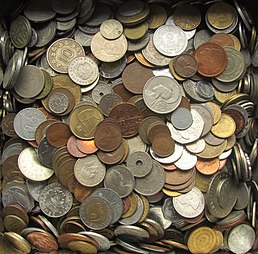
A coin is a small, flat, (usually, depending on the country or value) round piece of metal or plastic used primarily as a medium of exchange or legal tender. They are standardized in weight, and produced in large quantities at a mint in order to facilitate trade. They are most often issued by a government. Coins often have images, numerals, or text on them. Obverse and its opposite, reverse, refer to the two flat faces of coins and medals. In this usage, obverse means the front face of the object and reverse means the back face. The obverse of a coin is commonly called heads, because it often depicts the head of a prominent person, and the reverse tails.
Coins are usually metal or an alloy, or sometimes made of manmade materials. They are usually disc shaped. Coins made of valuable metal are stored in large quantities as bullion coins. Other coins are used as money in everyday transactions, circulating alongside banknotes. Usually the highest value coin in circulation (excluding bullion coins) is worth less than the lowest-value note. In the last hundred years, the face value of circulation coins has occasionally been lower than the value of the metal they contain, for example due to inflation. If the difference becomes significant, the issuing authority may decide to withdraw these coins from circulation, possibly issuing new equivalents with a different composition, or the public may decide to melt the coins down or hoard them (see Gresham's law).
Exceptions to the rule of face value being higher than content value also occur for some bullion coins made of copper, silver, or gold (and, rarely, other metals, such as platinum or palladium), intended for collectors or investors in precious metals. Examples of modern gold collector/investor coins include the British sovereign minted by the United Kingdom, the American Gold Eagle minted by the United States, the Canadian Gold Maple Leaf minted by Canada, and the Krugerrand, minted by South Africa. While the Eagle, and Sovereign coins have nominal (purely symbolic) face values, the Krugerrand does not.
Historically, a considerable variety of coinage metals (including alloys) and other materials (e.g. porcelain) have been used to produce coins for circulation, collection, and metal investment: bullion coins often serve as more convenient stores of assured metal quantity and purity than other bullion.[1]
History[edit]
Bullion and unmarked metals[edit]
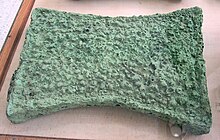
Metal ingots, silver bullion or unmarked bars were probably in use for exchange among many of the civilizations that mastered metallurgy. The weight and purity of bullion would be the key determinant of value. In the Achaemenid Empire in the early 6th century BCE, coinage was yet unknown, and barter and to some extent silver bullion was used instead for trade.[2] The practice of using silver bars for currency also seems to have been current in Central Asia from the 6th century BCE.[3]
Coins were an evolution of "currency" systems of the Late Bronze Age, where standard-sized ingots, and tokens such as knife money, were used to store and transfer value. In the late Chinese Bronze Age, standardized cast tokens were made, such as those discovered in a tomb near Anyang.[4][5] These were replicas in bronze of earlier Chinese currency, cowrie shells, so they were named Bronze Shell.[6]
Lydian and Ionian electrum coins (circa 600 BCE)[edit]

The earliest coins are mostly associated with Iron Age Anatolia of the late 7th century BCE, and especially with the kingdom of Lydia.[8] Early electrum coins (an alluvial alloy of gold and silver, varying wildly in proportion, and usually about 40–55% gold) were not standardized in weight, and in their earliest stage may have been ritual objects, such as badges or medals, issued by priests.[9] The unpredictability of the composition of naturally occurring electrum implied that it had a variable value, which greatly hampered its development.[10]
Most of the early Lydian coins include no writing ("myth" or "inscription"), only an image of a symbolic animal. Therefore, the dating of these coins relies primarily on archaeological evidence, with the most commonly cited evidence coming from excavations at the Temple of Artemis at Ephesus, also called the Ephesian Artemision (which would later evolve into one of the Seven Wonders of the Ancient World), site of the earliest known deposit of electrum coins.[7] Because the oldest lion head "coins" were discovered in that temple, and they do not appear to have been used in commerce[citation needed], these objects may not have been coins but badges or medals issued by the priests of that temple[citation needed]. Anatolian Artemis was the Πὀτνια Θηρῶν (Potnia Thêrôn, "Mistress of Animals"), whose symbol was the stag. It took some time before ancient coins were used for commerce and trade[citation needed]. Even the smallest-denomination electrum coins, perhaps worth about a day's subsistence, would have been too valuable for buying a loaf of bread.[11] Maybe the first coins to be used for retailing on a large-scale basis were likely small silver fractions, Hemiobol, Ancient Greek coinage minted by the Ionian Greeks in the late sixth century BCE.[12]
In contrast Herodotus mentioned the innovation made by the Lydians:[10]
"So far as we have any knowledge, they [the Lydians] were the first people to introduce the use of gold and silver coins, and the first who sold goods by retail"
And both Aristotle (fr. 611,37, ed. V. Rose) and Pollux (Onamastikon IX.83), mention that the first issuer of coinage was Hermodike/Demodike of Cyme.[13][14]Cyme was a city in Aeolia, nearby Lydia.
"Another example of local pride is the dispute about coinage, whether the 1rst one to strike it was Pheidon of Argos, or Demodike of Kyme (who was wife of Midas the Phrygian and daughter of King Agammemnon of Kyme), or Erichthonios and Lycos of Athens, or the Lydians (as Xenophanes says) or the Naxians (as Anglosthenes thought)"
Many early Lydian and Greek coins were minted under the authority of private individuals and are thus more akin to tokens or badges than to modern coins,[16] though due to their numbers it is evident that some were official state issues. The earliest inscribed coins are those of Phanes, dated to 625–600 BC from Ephesus in Ionia, with the legend ΦΑΕΝΟΣ ΕΜΙ ΣΕΜΑ (or similar) (“I am the badge/sign/tomb of Phanes/light”),[17] or just bearing the name ΦΑΝΕΟΣ (“of Phanes”).
The first electrum coins issued by a monarch are those minty by king Alyattes of Lydia (died c. 560 BCE), for which reason this king is sometimes mentioned as the originator of coinage.[18]
Croesus: Pure gold and silver coins[edit]


The successor of Alyattes, king Croesus (r. c. 560–546 BCE), became associated with great wealth in Greek historiography. He is credited with issuing the Croeseid, the first true gold coins with a standardized purity for general circulation.[10] and the world's first bimetallic monetary system c. 550 BCE.[10]
Coins spread rapidly in the 6th and 5th centuries BCE, leading to the development of Ancient Greek coinage and Achaemenid coinage, and further to Illyrian coinage.[19]
Standardized Roman currency was used throughout the Roman Empire. Important Roman gold and silver coins were continued into the Middle Ages (see Gold dinar, Solidus, Aureus, Denarius). Ancient and early medieval coins in theory had the value of their metal content, although there have been many instances throughout history of governments inflating their currencies by debasing the metal content of their coinage, so that the inferior coins were worth less in metal than their face value. Fiat money first arose in medieval China, with the jiaozi paper money. Early paper money was introduced in Europe in the later Middle Ages, but some coins continued to have the value of the gold or silver they contained throughout the Early Modern period. The penny was minted as a silver coin until the 17th century.
Achaemenid coinage (546–330 BCE)[edit]


When Cyrus the Great (550–530 BC) came to power, coinage was unfamiliar in his realm. Barter and to some extent silver bullion was used instead for trade.[2] The practice of using silver bars for currency also seems to have been current in Central Asia from the 6th century.[3]
Cyrus the Great introduced coins to the Persian Empire after 546 BCE, following his conquest of Lydia and the defeat of its king Croesus, who had put in place the first coinage in history. With his conquest of Lydia, Cyrus acquired a region in which coinage was invented, developed through advanced metallurgy, and had already been in circulation for about 50 years, making the Lydian Kingdom one of the leading trade powers of the time.[2] It seems Cyrus initially adopted the Lydian coinage as such, and continued to strike Lydia's lion-and-bull coinage.[2]
Original coins of the Achaemenid Empire were issued from 520 BCE – 450 BCE to 330 BCE. The Persian Daric was the first truly Achaemenid gold coin which, along with a similar silver coin, the Siglos, represented the bimetallic monetary standard of the Achaemenid Persian Empire.[20]
Coinage of Southern Asia under the Achaemenid Empire[edit]
The Achaemenid Empire already reached the doors of India during the original expansion of Cyrus the Great, and the Achaemenid conquest of the Indus Valley is dated to c. 515 BCE under Darius I.[2] An Achaemenid administration was established in the area. The Kabul hoard, also called the Chaman Hazouri hoard,[23] is a coin hoard discovered in the vicinity of Kabul, Afghanistan, containing numerous Achaemenid coins as well as many Greek coins from the 5th and 4th centuries BCE.[22] The deposit of the hoard is dated to the Achaemenid period, in approximately 380 BCE.[24] The hoard also contained many locally produced silver coins, minted by local authorities under Achaemenid rule.[25] Several of these issues follow the "western designs" of the facing bull heads, a stag, or Persian column capitals on the obverse, and incuse punch on the reverse.[25][26]
According to numismatist Joe Cribb, these finds suggest that the idea of coinage and the use of punch-marked techniques was introduced to India from the Achaemenid Empire during the 4th century BCE.[27] More Achaemenid coins were also found in Pushkalavati and in Bhir Mound.[28]
Indian coins (circa 400 BCE–100 CE)[edit]
The Karshapana is the earliest punch-marked coin found in India, produced from at least the mid-4th century BCE, and possibly as early as 575 BCE,[30] influenced by similar coins produced in Gandhara under the Achaemenid empire, such as those of the Kabul hoard,[31] or other examples found at Pushkalavati and in Bhir Mound.[28]
Greek Archaic coinage (until about 480 BCE)[edit]

According to Aristotle (fr. 611,37, ed. V. Rose) and Pollux (Onamastikon IX.83), the first issuer of Greek coinage was Hermodike of Kyme.[33]
A small percentage of early Lydian/Greek coins have a legend.[34] A famous early electrum coin, the most ancient inscribed coin at present known, is from nearby Caria. This coin has a Greek legend reading phaenos emi sema[35] interpreted variously as "I am the badge of Phanes", or "I am the sign of light",[36] or "I am the tomb of light", or "I am the tomb of Phanes". The coins of Phanes are known to be among the earliest of Greek coins, a hemihekte of the issue was found in the foundation deposit of the temple of Artemis at Ephesos (the oldest deposit of electrum coins discovered). One assumption is that Phanes was a wealthy merchant, another that this coin is associated with Apollo-Phanes and, due to the Deer, with Artemis (twin sister of the god of light Apollo-Phaneos). Although only seven Phanes type coins were discovered, it is also notable that 20% of all early electrum coins also have the lion of Artemis and the sun burst of Apollo-Phaneos.
Alternatively, Phanes may have been the Halicarnassian mercenary of Amasis mentioned by Herodotus, who escaped to the court of Cambyses, and became his guide in the invasion of Egypt in 527 or 525 BCE. According to Herodotus, this Phanes was buried alive by a sandstorm, together with 50,000 Persian soldiers, while trying to conquer the temple of Amun–Zeus in Egypt.[37] The fact that the Greek word "Phanes" also means light (or lamp), and the word "sema" also means tomb makes this coin a famous and controversial one.[38]
Another candidate for the site of the earliest coins is Aegina, where Chelone ("turtle") coins were first minted circa 700 BCE.[39] Coins from Athens and Corinth appeared shortly thereafter, known to exist at least since the late 6th century BCE.[40]

Coin of Phaselis, Lycia. Circa 550–530/20 BCE.

Coin of Lycia. Circa 520–470/60 BCE.

Lycia coin. Circa 520-470 BCE. Struck with worn obverse die.[41]
Classical Greek antiquity (480 BCE~)[edit]
The Classical period saw Greek coinage reach a high level of technical and aesthetic quality. Larger cities now produced a range of fine silver and gold coins, most bearing a portrait of their patron god or goddess or a legendary hero on one side, and a symbol of the city on the other. Some coins employed a visual pun: some coins from Rhodes featured a rose, since the Greek word for rose is rhodon. The use of inscriptions on coins also began, usually the name of the issuing city.
The wealthy cities of Sicily produced some especially fine coins. The large silver decadrachm (10-drachm) coin from Syracuse is regarded by many collectors as the finest coin produced in the ancient world, perhaps ever. Syracusan issues were rather standard in their imprints, one side bearing the head of the nymph Arethusa and the other usually a victorious quadriga. The tyrants of Syracuse were fabulously rich, and part of their public relations policy was to fund quadrigas for the Olympic chariot race, a very expensive undertaking. As they were often able to finance more than one quadriga at a time, they were frequent victors in this highly prestigious event. Syracuse was one of the epicenters of numismatic art during the classical period. Led by the engravers Kimon and Euainetos, Syracuse produced some of the finest coin designs of antiquity.
Amongst the first centers to produce coins during the Greek colonization of mainland Southern Italy (Magna Graecia) were Paestum, Crotone, Sybaris, Caulonia, Metapontum, and Taranto. These ancient cities started producing coins from 550BCE to 510BCE.[42][43]
Amisano, in a general publication, including the Etruscan coinage, attributing it the beginning to about 560 BCE in Populonia, a chronology that would leave out the contribution of the Greeks of Magna Graecia and attribute to the Etruscans the burden of introducing the coin in Italy. In this work, constant reference is made to classical sources, and credit is given to the origin of the Etruscan Lydia, a source supported by Herodotus, and also to the invention of coin in Lydia.[44]
Appearance of dynastic portraiture (5th century BCE)[edit]
Although many of the first coins illustrated the images of various gods, the first portraiture of actual rulers appears with the coinage of Lycia in the 5th century BCE.[45][46] No ruler had dared illustrating his own portrait on coinage until that time.[46] The Achaemenids had been the first to illustrate the person of their king or a hero in a stereotypical manner, showing a bust or the full body but never an actual portrait, on their Sigloi and Daric coinage from circa 500 BCE.[46][47][48] A slightly earlier candidate for the first portrait-coin is Themistocles the Athenian general, who became a Governor of Magnesia on the Meander circa 465–459 BCE for the Achaemenid Empire,[49] although there is some doubt that his coins may have represented Zeus rather than himself.[50] Themistocles may have been in a unique position in which he could transfer the notion of individual portraiture, already current in the Greek world, and at the same time wield the dynastic power of an Achaemenid dynasty who could issue his own coins and illustrate them as he wished.[51] From the time of Alexander the Great, portraiture of the issuing ruler would then become a standard, generalized, feature of coinage.[46]

Coin of Themistocles as Governor of Magnesia. Obv: Barley grain. Rev: Possible portrait of Themistocles. Circa 465–459 BC.[52]

Portrait of Lycian ruler Kherei wearing the Persian cap on the reverse of his coins (ruled 410–390 BCE).

Portrait of Lycian ruler Erbbina wearing the Persian cap on the reverse of his coins (ruled 390–380 BCE).

Portrait of Lycian ruler Perikles facing (ruled 380-360 BCE).
Chinese round coins (350 BCE~)[edit]
In China, early round coins appeared in the 4th century BCE and were adopted for all China by Emperor Qin Shi Huang Di at the end of 3rd century BCE.[53] The round coin, the precursor of the familiar cash coin, circulated in both the spade and knife money areas in the Zhou period, from around 350 BCE. Apart from two small and presumably late coins from the State of Qin, coins from the spade money area have a round hole and refer to the jin and liang units. Those from the knife money area have a square hole and are denominated in hua (化).
Although for discussion purposes the Zhou coins are divided up into categories of knives, spades, and round coins, it is apparent from archaeological finds that most of the various kinds circulated together. A hoard found in 1981, near Hebi in north Henan province, consisted of: 3,537 Gong spades, 3 Anyi arched foot spades, 8 Liang Dang Lie spades, 18 Liang square foot spades and 1,180 Yuan round coins, all contained in three clay jars.
Hellenistic period (320 BCE – 30 CE)[edit]
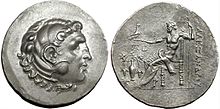
The Hellenistic period was characterized by the spread of Greek culture across a large part of the known world. Greek-speaking kingdoms were established in Egypt and Syria, and for a time also in Iran and as far east as what is now Afghanistan and northwestern India. Greek traders spread Greek coins across this vast area, and the new kingdoms soon began to produce their own coins. Because these kingdoms were much larger and wealthier than the Greek city states of the classical period, their coins tended to be more mass-produced, as well as larger, and more frequently in gold. They often lacked the aesthetic delicacy of coins of the earlier period.
Still, some of the Greco-Bactrian coins, and those of their successors in India, the Indo-Greeks, are considered the finest examples of Greek numismatic art with "a nice blend of realism and idealization", including the largest coins to be minted in the Hellenistic world: the largest gold coin was minted by Eucratides (reigned 171–145 BCE), the largest silver coin by the Indo-Greek king Amyntas Nikator (reigned c. 95–90 BCE). The portraits "show a degree of individuality never matched by the often bland depictions of their royal contemporaries further West" (Roger Ling, "Greece and the Hellenistic World").
Roman period (290 BCE~)[edit]
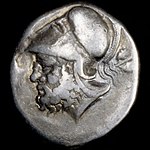 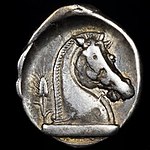 | |
| O: Bearded head of Mars with Corinthian helmet left. | R: Horse head right, grain ear behind. |
| The first Roman silver coin, 281 BCE. Crawford 13/1 | |
Coinage followed Greek colonization and influence first around the Mediterranean and soon after to North Africa (including Egypt), Syria, Persia, and the Balkans.[55] Coins came late to the Roman Republic
-
-